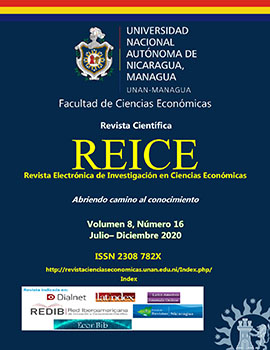Evaluación Del Índice De Similaridad De Exportación Compuesta Sobre El Ejemplo De China
DOI:
https://doi.org/10.5377/reice.v8i16.10677Palabras clave:
comercio internacional, comercio bilateral, competitividad de exportación, exportación globalResumen
El propósito de este artículo es mejorar el Índice de similitud de exportación para proporcionar resultados más confiables sobre si dos países son competidores potenciales e inmediatos en el comercio mundial y en qué medida. Para lograr esta metodología existente se complementó con el conjunto de destinos geográficos. Esto permite evaluar la superposición de las carteras de exportación de dos o más países y comprender el posible nivel de su competencia en el comercio internacional. Para demostrar la eficiencia de este índice mejorado, se comparó la cartera de exportaciones de China con los 50 mayores exportadores. Los resultados obtenidos demuestran una fuerte superposición del comercio chino con Vietnam, Japón y Filipinas, lo que demuestra la veracidad de la metodología introducida.
Descargas
849
Citas
Didarul, H. (2006). Measuring export competitiveness in South Asia: Export similarity index approach. The Chittagong University Journal of Social Sciences, 24(1), 141-152.
Erlat, G., & Ekmen, S. (2009). Export similarity and competitiveness: The case of Turkey in the EU market. In: Proceedings of Anadolu International Conference in Economics, pp. 1-27. Eskişehir: Anadolu University.
Finger, J.M., & Kreinin, M.E. (1979). A measure of “export similarity” and its possible uses. The Economic Journal, 89(356), 905-912. doi: https://doi.org/10.2307/2231506
Ha, T.H.V. (2011). Intermediate goods trade between Vietnam and China. In: M. Kagami (ed.), Intermediate Goods Trade in East Asia: Economic Deepening Through FTAs/EPAs. Bangkok: Bangkok Research Center.
International Trade Center. (2020). Retrieved from http://www.trademap.org
Johansson, A., & Olaberría, E. (2014). Global trade and specialization patterns over the next 50 years. Paris: OECD Publishing.
Kellman, M., & Schroder, T. (1983). The export similarity index: Some structural tests. The Economic Journal, 93(369), 193-198. doi:10.2307/2232173
Khan, M.T. (2004). China, WTO and the developing countries: a constructivist analysis. Ankara: Ministry of Foreign Affairs of the Republic of Turkey.
Li, K.K. (2018). China and India trade competition and complementary: Analysis of the “Belt and Road” background. Modern Economy, 9, 1213-1227.
Ma, T., Liu, Y., & Ge, Y. (2017). A comparative study of trade relations and the spatial-temporal evolution of geo-economy between China and Vietnam. Sustainability, 9, 944.
Mikic, M., & Gilbert, J. (2007). Trade statistics in policymaking: A handbook of commonly used trade indices and indicators. Bangkok: United Nations ESCAP.
Pritesh, S. (2020). US – China trade war inspires Vietnam growth. Vietnam Briefing. Retrieved from https://www.vietnam-briefing.com/news/us-china-trade-war-inspires-vietnam-growth.html/
Schniederjans, M.J., Cao, Q., Schniederjans, D., & Gu, V.C. (2011). Consumer perceptions of product quality revisited: Made in China. Quality Management Journal, 18(3), 52-68. doi: 10.1080/10686967.2011.11918322
Schoot, P.K. (2004). The relative similarity of China’s exports to the United States vis a vis other U.S. trading partner. Unpublished Manuscript, 7, 15-23.
Wang, P., & Liu, X. (2015). Comparative analysis of export similarity index between China and EU. In: International Conference on Management Science and Management Innovation, pp. 222-227. Guilin: Atlantis Press. doi: https://doi.org/10.2991/msmi-15.2015.42
Wang, Z., Gehlhar, M., & Yao, S. (2007). Reconciling trade statistics from China, Hong Kong and their major trading partners: A mathematical programming approach. Retrieved from https://www.researchgate.net/publication/5081714_Reconciling_Trade_Statistics_from_China_Hong_Kong_and_Their_Major_Trading_Partners--A_Mathematical_Programming_Approach
World Bank. (2020). Retrieved from http://www.worldbank.org
Xu, X., & Song, L. (2000). Export similarity and the pattern of East Asian development. In: P.J. Lloyd, & Z. Xiao-Guang (eds.), China in The Global Economy, pp. 145-165. Cheltenham: Edward Elgar Publishing.
Yen, N.L. (2019). These charts show Vietnam is far from matching China’s manufacturing prowess. Retrieved from https://www.cnbc.com/2019/10/29/trade-war-can-vietnam-replace-china-as-a-global-manufacturing-hub.html
Descargas
Publicado
Cómo citar
Número
Sección
Licencia
Copyright (c) Revista Electronica de Investigacion en Ciencias Economicas
Los derechos sobre los artículos publicados en REICE son de la revista, a los efectos de poder gestionar su mejor difusión. No obstante, puesto que la finalidad de la misma es la difusión del conocimiento, esta revista provee acceso libre inmediato a su contenido, bajo el principio de que hacer disponible gratuitamente la investigación al público, lo cual fomenta un mayor intercambio de conocimiento global.
Las opiniones expresadas por los autores no necesariamente reflejan la postura de la editora de la publicación ni de la UNAN-Managua Se autoriza su reproducción y distribución (en cualquier tipo de soporte) siempre que se cumpla las siguientes indicaciones:
- La autoría del trabajo
- Que se indique su origen (revista REICE, volumen, número y dirección electrónica del documento)

